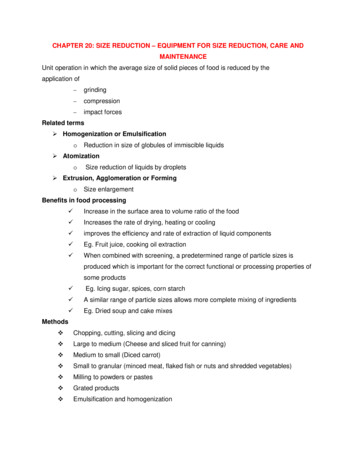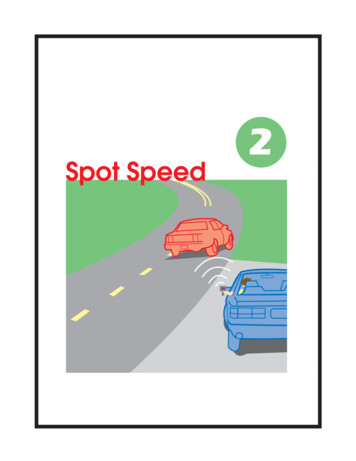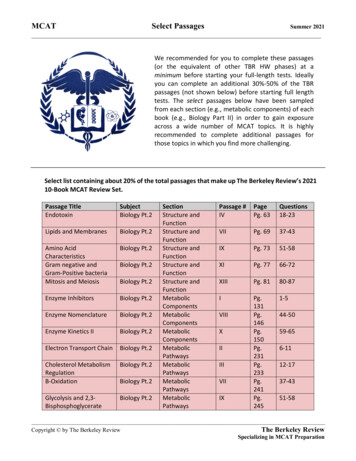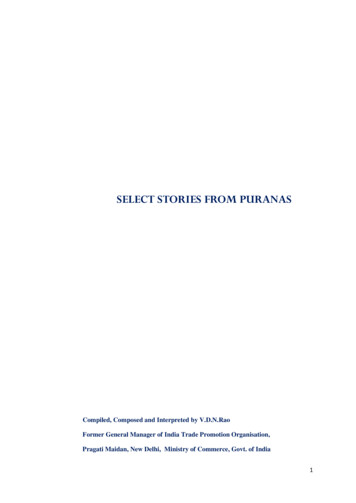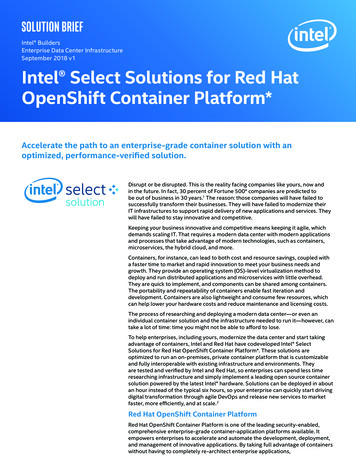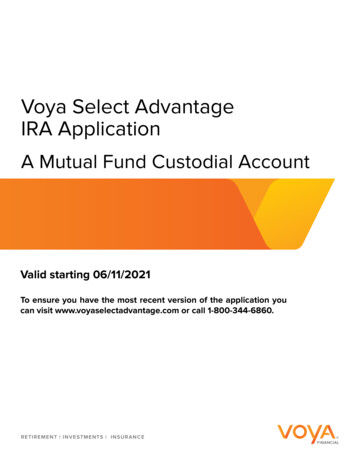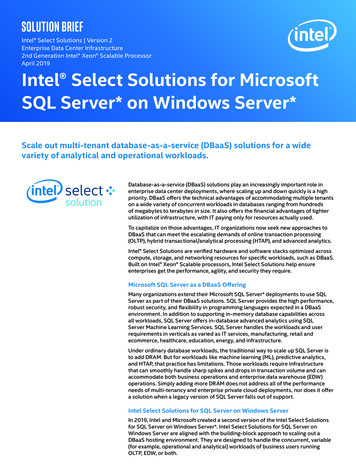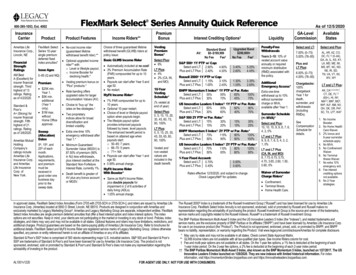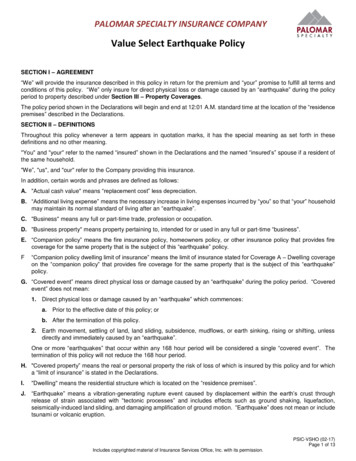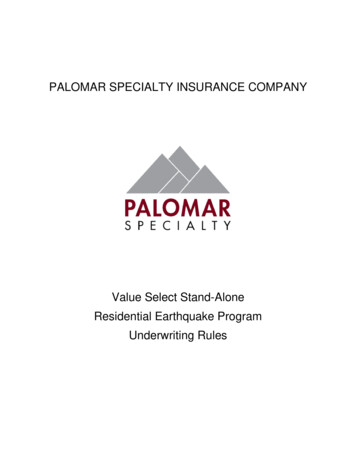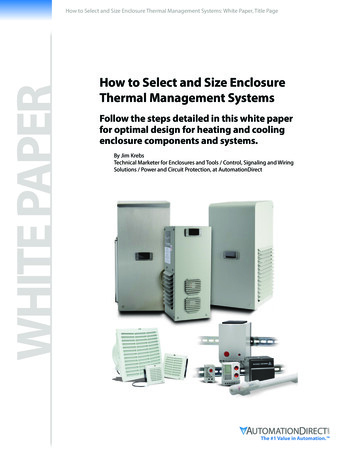
Transcription
WHITE PAPERHow to Select and Size Enclosure Thermal Management Systems: White Paper, Title PageHow to Select and Size EnclosureThermal Management SystemsFollow the steps detailed in this white paperfor optimal design for heating and coolingenclosure components and systems.By Jim KrebsTechnical Marketer for Enclosures and Tools / Control, Signaling and WiringSolutions / Power and Circuit Protection, at AutomationDirectThe #1 Value in Automation.
WHITE PAPERHow to Select and Size Enclosure Thermal Management Systems: White Paper, pg. 2Housing electrical components inside an enclosure is a requirement in industrialapplications. The enclosure is required to protect the controllers, power distributioncomponents, power supplies and other electronics from harsh factory floorenvironments. Factories, plants and facilities often experience relatively warmambient temperatures, and many of the electrical components housed in the controlenclosure generate heat, so many enclosures require cooling. In some instances, suchas for outdoor installations, enclosures may require heating.When fluctuating ambient temperatures exist, cooling and/or heating are oftenrequired to maintain optimal operating temperatures, keep condensation fromforming, and prevent components from overheating or freezing. There are manyproducts available to keep enclosures and the components housed inside within anacceptable temperature range.Enclosure Thermal ManagementControlling internal temperature is done by transferring heat into or out of anenclosure. The three heat transfer mechanisms used are convection, conduction andradiation. Convection is the movement of heat through a moving fluid, a gas or aliquid, or from a moving fluid to the surface of a solid. Conduction is the flow of heatthrough solid material, such as the enclosure itself, or between two solids. Radiationis the transfer of thermal energy via conversion to and from electrical energy, such aswith an electric strip heater.This white paper discusses the different types of enclosure thermal managementsystems used to maintain optimum conditions inside enclosures. The paper willexamine the wide assortment of heaters, air conditioners, heat exchangers, vortexcoolers, venting devices and control units designed to provide efficient andcost-effective climate control of an enclosure.Keeping a Consistent TemperatureIn most cases, enclosure heating is not used to keep internal components warm. Infact, most electric and electronic components perform better at colder temperatures.The exception is when an enclosure is installed outside in an area where ambienttemperatures dip well below freezing. In these situations, heating is required to keepinternal temperatures within the operating range of electrical components.More typically, heating is needed to reduce moisture and related corrosion. The goalof enclosure heating is to keep the relative humidity inside the enclosure below 65%.A consistent temperature inside a control enclosure helps guarantee optimaloperating conditions and prevent condensation. In some applications, an enclosuremay need to be cooled during the day and heated at night.Save on Enclosure Climate Control -ControlThe #1 Value in Automation.
How to Select and Size Enclosure Thermal Management Systems: White Paper, pg. 3WHITE PAPERIf a heater is used, its placement is important. Optimal performance is achieved byplacing a heater near the bottom of an enclosure to allow natural convection forheat distribution. Larger enclosures often require fan heaters to distribute the heatthroughout the enclosure. Generally, heaters over 150 Watts will include an axial fanto move the heat throughout the enclosure.Five Steps to Determine Heating RequirementsCalculations to determine the required heater size include the following fivesteps. Imperial or metric units can be used, but consistency among units mustbe maintained.1. Determine the Enclosure Surface Area (A) exposed to open airEnclosure Dimensions:height feetwidth feetdepth feetmetersmetersmetersThe enclosure surface area and related conduction varies depending onmounting method such as free-standing or wall mounted. Choose themounting method using Figure 2, and calculate the surface area asindicated: A ft2 or m2Figure 2: Enclosure Mounting Types and Surface Area Calculationsa. Free-StandingArea (A) 1.8 (H x W) 1.8 (H x D) 1.8 (W x D)Area (A) 1.8 (H x W) 1.4 (H x D) 1.8 (W x D)Save on Enclosure Climate Control -ControlArea (A) 1.8 (H x W) (H x D) 1.8 (W x D)The #1 Value in Automation.
WHITE PAPERHow to Select and Size Enclosure Thermal Management Systems: White Paper, pg. 4b.Wall-Mounted:Area (A) 1.4 (H x W)Area (A) 1.4 (H x W)Area (A) 1.4 (H x W) 1.8 (H x D) 1.8 (W x D) 1.4 (H x D) 1.8 (W x D) (H x D) 1.8 (W x D)c.Ground:Area (A) 1.8 (H x W) 1.8 (H x D) 1.4 (W x D)d.Area (A) 1.8 (H x W)Area (A) 1.8 (H x W) 1.4 (H x D) 1.4 (W x D) (H x D) 1.4 (W x D)Ground and Wall:Area (A) 1.8 (H x W)Area (A) 1.8 (H x W) 1.8 (H x D) 1.4 (W x D) 1.4 (H x D) 1.4 (W x D)Area (A) 1.8 (H x W) (H x D) 1.4 (W x D)2. Choose a Heat Transmission Coefficients (k) value (imperial or metric) from thetable below based on the enclosure construction material:Enclosure MaterialCoefficient (W/ft2 K)Coefficient W/(m2 K)Painted Steel0.5115.5Stainless Steel0.3443.7Aluminum1.11512Plastic or Insulated Stainless Steel0.3253.5Coefficient (k) Value selected (Imperial) W/(ft2 K) or (metric) W/(m2 K)Save on Enclosure Climate Control -ControlThe #1 Value in Automation.
How to Select and Size Enclosure Thermal Management Systems: White Paper, pg. 5 3. Determine the Temperature Differential (ΔT).a. Desired enclosure interior temperature b. Lowest ambient (outside) temperature F C F CWHITE PAPERSubtract a from b Temperature differential (ΔT) F CΔT ( K) ΔT ( F) / 1.8 or ΔT ( K) ΔT ( C)Note: For these calculations, ΔT must be in degrees Kelvin ( K) so ΔT ( F) is divided by 1.8. 4. Determine Component Heating Power (PV). This includes heat generatedby internal components such as transformers, power supplies, etc. Mostelectrical devices, based on efficiency, add heat to a control enclosure.PV W or W5. Calculate the required Heating Power (PH) based on the previous valuesIf the enclosure is located inside:PH (A x k x ΔT) - PV W If the enclosure is located outside:PH 2 x (A x k x ΔT) - PV WThere are a wide variety of electrical enclosure heaters for thermal management,providing temperature and moisture control. The AutomationDirect website hastouch-safe positive temperature coefficient heaters to prevent the formation ofcondensation and provide evenly distributed interior air temperature in enclosures.Some selection choices include heater units with or without fans. It is also importantto choose an operating voltage compatible with the control system.Heaters should always be controlled with a thermostat or a hygrostat to turn themOFF when the enclosure internal temperature and/or relative humidity is sufficient toprevent condensation. Controls may be adjustable or preset to fixed ON/OFF setpoints.Control devices may be integrated into the heater, or may be an independent device.Cooling a Control EnclosureThere are many reasons to add cooling to a control enclosure. Heat may be addedto an enclosure from internal components such as drives and power supplies, orfrom external sources such as ovens, furnaces, foundry equipment, etc. Excess heatdecreases life expectancy of control components such as programmable logiccontrollers, human machine interfaces, and AC drives. Heat can also cause electrical/electronic component problems including overload tripping, change in performanceof circuit breakers and fuses, power failures, and more.The cooling method used depends on the combined internal and external enclosureSave on Enclosure Climate Control -ControlThe #1 Value in Automation.
How to Select and Size Enclosure Thermal Management Systems: White Paper, pg. 6WHITE PAPERheat load. Heat flows from higher temperature to lower temperatures, so ambienttemperature plays a significant role, with higher ambient temperatures adding to therequired cooling.The enclosure protection rating is also important, as sealed enclosures will retainmore heat than those vented to ambient. If the heat inside an enclosure cannot bevented while keeping outside contaminants out, then other cooling methods mustbe considered to maintain the enclosure rating. There are several types of coolingmethods including natural convection, forced convection, closed-loop cooling andvortex cooling.Enclosure Cooling: Natural and Forced ConvectionConvection is the primary mechanism used to control the temperature inside anenclosure. The rate of convection dependson the movement of air. The faster the airmoves inside the enclosure, the fasterheat transfer occurs. Natural convection iscaused by hot air rising, which can circulateair inside and can keep many enclosurescool. However, forced convection with afan provides higher heat transfer rates. Inboth cases, convection occurs when relativelycool ambient air reduces the internal enclosuretemperature. Convection cannot be used toeffectively cool an enclosure when ambienttemperatures are high.If cooling requirements are low, naturalconvection using grilles with filters are oftenthe preferred solution. Proper installationallows cool convection air to enter at theenclosure bottom and exit near the top.Grille: In fiberglass enclosures, a breather ventcan be used to provide convection cooling,and a drain vent can be used to remove moisture. Thesevents maintain a UL 4X enclosure rating.Vent: Forced convection is a good option when clean andcool outside air is available. To forceair, a filter fan and grille are mounted low on the enclosure andused to force relatively cool ambient air into the enclosure. Anexhaust grille, mounted high on the enclosure, allows hot air inthe enclosure to exhaust.Filter Fan: Forced convection creates a constant air flow throughSave on Enclosure Climate Control -ControlThe #1 Value in Automation.
How to Select and Size Enclosure Thermal Management Systems: White Paper, pg. 7WHITE PAPERthe enclosure to prevent localized heat pockets, and to protect components from overheating. If hot spots are a concern, for example withcomponents generating excessive amounts ofheat, compact fans can provide spot cooling tofocus air where required.STEGO enclosure exhaust grilles with filters, filter fansand compact fans, and Hubbell-Wiegmann vents, louver plates and filters, availablefrom AutomationDirect, provide a wide selection of natural and forced convectioncooling solutions. These vents & louver plates and filter fans are available forapplications where natural and forced convection creates sufficient cooling.Enclosure Cooling: Closed Loop CoolingClosed loop cooling is used when theambient temperature is as high or higherthan the desired internal temperature,or when internal components generateexcessive heat. It’s also used when thereis a need to maintain temperature insidean enclosure at or below safe levelsfor the equipment/components withoutintroducing outside air into the enclosure.Closed loop cooling is typically used in: Harsh environments Areas where washdown is required Areas with heavy dust and debris Areas where chemicals are airborne Areas with high ambient temperatures Enclosures with internal components generating excessive heatClosed loop cooling options offered by AutomationDirect, which maintain theenclosure protection rating, include Stratus enclosure air conditioners and air-to-airheat exchangers. The primary differences between the operation of an enclosureair conditioner and an enclosure heat exchanger is the refrigerant and how it iscirculated through the evaporator and the condenser.Enclosure Air Conditioners: The high efficiency andeffectiveness of an air conditioner does come at a price.The compressor uses much more electrical power thana filter fan or a heat exchanger, but energy-efficientcompressors and programmable temperature controllershelp keep energy costs in check.Save on Enclosure Climate Control -ControlThe #1 Value in Automation.
How to Select and Size Enclosure Thermal Management Systems: White Paper, pg. 8WHITE PAPERRefrigerant-Free Vortex Coolers: Vortex coolersaren’t closed loop because they displace hot airinside the enclosure with cold air from the outside. However, since the cold air comes from afiltered compressed air system, they still maintainNEMA enclosure ratings.The vortex generator inside the cooler creates avortex that rotates the compressed air supply atspeeds up to 1,000,000 rpm, with the rotation separating the air into hot and cold airstreams. The hot air stream is vented to the atmosphere, while the super-cooled air isforced through the center of the incoming air stream through the cold air exhaust portand into the enclosure. Hot air from the enclosure is forced out through a vent. Vortexcoolers generate a stream of cold air using nothing except compressed air,with nofans, moving parts, or electrical power required.Like an air conditioner, a vortex cooler is effective even in highambient temperatures. Vortex coolers, such as those manufacturedby Stratus, are useful when air conditioner or heat exchanger coolingis not possible. This includes small to medium size enclosures, nonmetallic enclosures, areas where the size of cooling devices isrestricted, and areas where access to electrical power is limit
Calculations to determine the required heater size include the following five . steps. Imperial or metric units can be used, but consistency among units must be maintained. etermine the Enclosure Surface Area (A) exposed to open air1. D. Enclosure Dimensions: height _feet _meters width _feet _meters
